Community Blog “I’m an Artist and a Jew”: The Community and Creative Minds of the Artist Beit Midrash
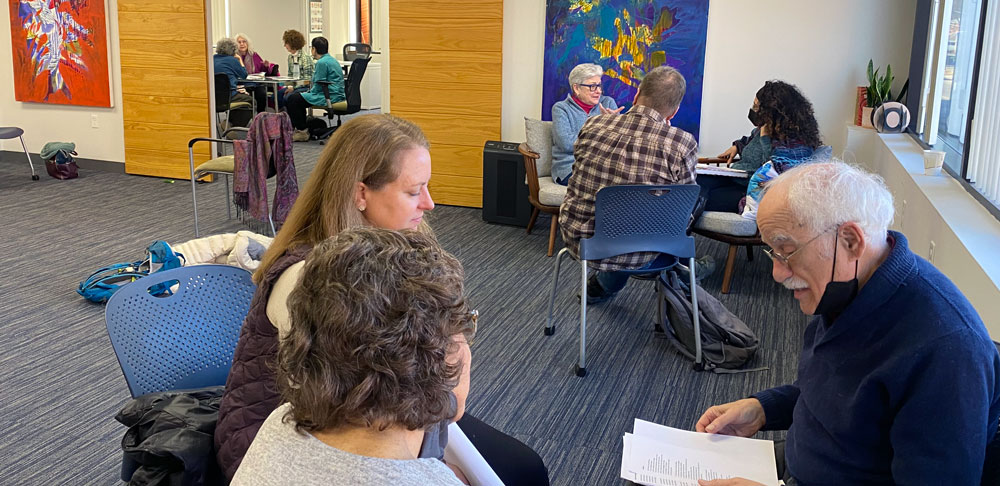
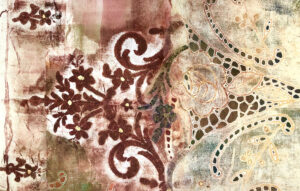
“There’s a saying about Jewish people: we are always running,” said Sandra Mayo, an Argentinean professional artist and alumna of the Artist Beit Midrash, a program of Hebrew College and JArts. “My grandfather was born in Ottoman, Türkiye, and when he emigrated to Argentina, one of the only things he brought was some Ottoman fine embroidery velvet which he had donated to the community synagogue for a Torah cover. It was very important to him,” she remembers. “So, I’m making a print with the scraps from the cover. And this is all thanks to the Artist Beit Midrash. It pushed me to reconnect with my Jewish history.”
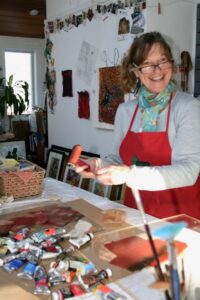
The Artist Beit Midrash is a Jewish learning salon that brings together Boston-area Jewish creators to study Jewish text, reflect on their creative process, and build community. Mayo was a member of the first cohort and coordinates alumni events now. “I’m an Artist and a Jew,” Mayo added. “They are both who I am.”
In partnership with the Jewish Arts Collaborative (JArts) & Combined Jewish Philanthropies of Greater Boston (CJP), Hebrew College launched the Artist Beit Midrash in 2021. The community includes writers, installation artists, sculptors, photographers, singers, theater directors, textile painters, memoirists, poets, potters, and more. The 30 participants come together for monthly cohort sessions that include hevruta (partner) study of classical and contemporary texts, and group conversations about the creative process as a spiritual path. They come with varying understandings of both the words “Jewish” and “artist.”
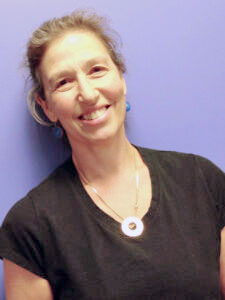
For some participants, the Artist Beit Midrash is the first time they are considering their creative work and Jewish identity in the same breath. For others, the link between their art and their Jewishness is clear. “My dance is very linked to my spirituality as a Jew,” said Julie Leavitt, a dancer and dance therapist.
Allen M. Spivack, a sculptor who works primarily with steel and found objects participating for his second year in the Artist Beit Midrash, concurred, “For me, Judaism is central to my existence as a person. It infuses everything I do, so, a lot of my art does reflect Jewish themes, whether directly or indirectly.”

In the Torah learning, the Artist Beit Midrash connects creativity as spiritual path to Judaism as a spiritual path. Corine (Coco) Rosenberg, a printmaker, painter, and poet, said “Creativity connects me so much to the divine, to finding the sacred, to feeling connected to my aliveness.” They added, “Judaism offers us much of this wisdom too… and invites us into the act of creating our lives anew alongside one another as we work on Tikkun Olam (repairing the world) and question and learn together.” Rosenberg also appreciated that the definition of sacred text is broad. “In the Artist Beit Midrash, Torah expands to include also the pieces of art that we engage with and are even making ourselves.”
This year’s cohort is especially diverse, bringing a breadth of different mediums and life experiences to the Artist Beit Midrash. In addition to visual artists and writers of all kinds, the 2022 cohorts include dancers, spoken word artists, podcast creators, storytellers and people who focus on public art narratives for the first time. “It’s inspiring to witness participants share tenderly and personally about their creative process, all using Torah study as the door to the conversation. I can feel the pulsing undercurrent of creative spirit that enlivens all our lives across mediums,” said Rabbi Shoshana Meira Friedman, the director of the Hebrew College-JArts Artist Beit Midrash and a Hebrew College Rabbinical School graduate.
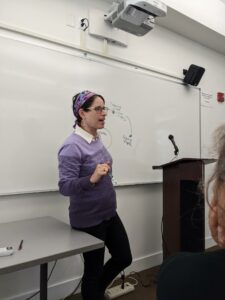
The Artist Beit Midrash is different from other Jewish arts programs. “We were very inspired by the Jewish Studio Project (founded by Rabbi Adina Allen `14),” explained Friedman. “But the Artist Beit Midrash has a different mission. The program is for Jews with an existing serious creative practice.” That said, the program has a wide tent. “We accept people regardless of training or accomplishments,” Friedman continued. “We have participants whose art has hung in world-class museums, and who have published successful books. And we have people who paint or write for their family and friends, teach theater to teens, and everything in between. We don’t spend much time in sessions talking about our finished work. Instead, we learn Torah together and reflect on the spiritual and psychological dimensions of creating—and that is a great equalizer,” she added.
“There are so many creative approaches to Jewish learning in Boston, but none specifically for artists or through an artistic lens,” said Laura Mandel, the executive director of Jewish Arts Collaborative. “The Artist Beit Midrash emanated from a wish for a space like this, shared by artists Caron Tabb, Anthony Russell, Shira Rubin, and Rabbi Shoshana Friedman initially. It’s beautiful to see their dream become a whole new kind of arts based Jewish community, and I look forward to seeing more of the art and collaborations that emerge from this.”
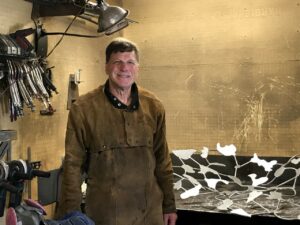
This year’s curriculum is inspired by the work of activist and teacher Dr. Joanna Macy. Sessions support artists in honoring their pain for the world and moving through that pain to service. “I really enjoy arguing with God, and raging against God, and I’m really able to do that in my art,” said Spivack. In one of these pieces, titled “Nuclear Triptych,” the Hebrew letters spelling out God’s most holy name—Yud, Heh, Vav, Heh—crash into the ground. “It’s my attempt to put a finger in God’s eye,” described Allen M. Spivack. “After all is said and done, it’s nice to make up with HaShem and sing a niggun together.”
“The Artist Beit Midrash helped me to appreciate and understand my rage, and to find a healthier place for my art in my own life,” said Spivack.
Current and past members may come from a variety of different mediums and life experiences—but they are united by a profound appreciation and deep respect for Friedman and the community she’s helped facilitate. “Shoshana is unbelievable,” said Mayo. “We come from different mediums, different ages, different needs…and she was able to bring us all together and create a community.”
“Shoshana does such a beautiful job of curating texts and interspersing bits of texts with questions so that we’re listening to these texts…asking ourselves how it relates to our lives, our artmaking, and how we learn about the world,” added Julie Leavitt.
If you spend any amount of time with the people of the Artist Beit Midrash, one thing becomes very apparent: it’s a space defined by the people that make it up. “Being in community with the other artists—sharing a common sensibility and a common language—has been wonderful,” said Spivack. “It’s also challenged me in ways I didn’t expect to be challenged. There have been subtle shifts in how I think about things… [for example,] It’s been very different to be in a cohort that has few men in it, and it’s been enriching for me.”
“My art making must happen in relationship, in community, and the Artist Beit Midrash cultivates this explicitly in its practice,” Rosenberg added.
For more information about the Artist Beit Midrash, please contact Rabbi Shoshana Meira Friedman at Hebrew College.

